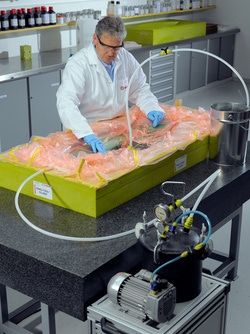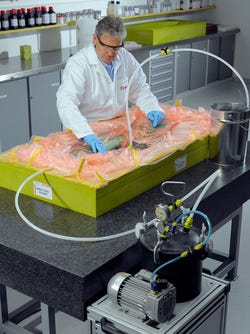August 29, 2016

Fiber-reinforced thermoset plastics are becoming increasingly important, particularly in the drive for lightweighting to reduce energy consumption while maintaining mechanical resilience. To that end, more and more composite components are being used in the automotive, aviation and leisure industries.
 Rampf Holding GmbH (Grafenberg, Germany) has introduced tooling solutions for resin transfer molding (RTM) and the resin infusion (RI) process: The epoxy infusion system Raku-Tool EI-2500/EH-2973.
Rampf Holding GmbH (Grafenberg, Germany) has introduced tooling solutions for resin transfer molding (RTM) and the resin infusion (RI) process: The epoxy infusion system Raku-Tool EI-2500/EH-2973.
Unlike metals, high-performance components produced from fiber composites make even small- and medium-series production profitable, especially when using RTM and RI. RTM is ideal for small- and medium-series production, while RI is mainly used for small series, prototypes and molds. Both processes produce components with excellent mechanical properties and fiber content by volume typically around 50 to 60% and minimal variation in thickness, explained Rampf. Complex geometries are also possible.
“The main advantage of the RI process lies in the component quality, especially in terms of air pockets,” said Marcus Vohrer, Head of Application Engineering at Rampf Tooling Solutions. “The RTM process scores particularly highly on process reliability and reproducibility. Occupational hygiene isn’t an issue for either process, because there’s hardly any contact with chemicals for staff.”
The advantages for users of the new epoxy infusion system, which was developed specifically for RTM and RI, include Class A+ surfaces; curing at room temperature and post-curing at just 120o C, which delivers optimum temperature resistance; and excellent processing properties including the possibility of long flow paths.
The Raku-Tool product range from Rampf Tooling Solutions includes products for both RTM and RI production as well as a large selection of liquid, paste, close contour casting and board materials. Applications include modeling, mold engineering, construction of jigs and fixtures and various production processes for lightweight composites, including prepreg autoclave, vacuum bag, wet lamination and compression molding processes.
About the Author(s)
You May Also Like



